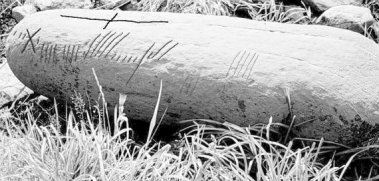Location and history:
For the location and discovery, cd. {155}.
Size according to Macalister, CIIC: 3'5" x 1'10" x 0'7";
No size is given by Brash, OIM 205 ("No. 9".
Published illustrations:
- Macalister, CIIC 1, 157 (
 draft).
draft).
Reading Ferguson, PRIA 15, 1871, 62:
"S(outh) side":
NETTALAMINAQC[AODE]
"N(orth) side":
MAQQIMUCOID[OROS?]
"Proposed Verbation":
[ ?] maqqi mucoi d[oros?]
The stone is assigned "No. XVI" in Ferguson's "List of Moulds of
Inscribed Stones from .. Localities in the Barony of Corkaguiney".
Reading Brash, OIM 205 ("No. 9"):
ᚂᚋᚔᚅᚐᚊᚉᚐᚕᚔᚋ:ᚊᚊᚔᚋᚒ
LMINAQCA I QQIMU
"The characters are much defaced, and very difficult to transcribe .. The inscription is defective at the end, and probably one or more characters have been lost at the beginning; there are only slight traces of the MA of MAQI. The terminal letters form the commencement of the oft met with Mucoi, which in this instance was very probably the patronymic." Of Ferguson's reading, the first five letters, `Netta', and the last three, `Mucoid', cannot be identified on his paper cast. Brash's copy agrees with Col. Lane Fox's, however. - Another stone "on the Keel", measuring 3' x 1'2" x 11", "bears no inscription".
NETTALAMINACCAP/E⌣AUIMAQQIMuCOIDOros
Nettal minacca pui maqqi mucoi Do(ros).<
The "reading is complicated by the presence of the ᚕ character.. It is plain, from the conccurence of vowels flanking the ᚕ, that it cannot be the diphthong here. - "Netta and pui are new." As for Netta, "I had first no doubt that it formed part of a proper name, Nettalami, but the cast refuses to admit an a after the l, and compels us to read ettal minacca, which certainly calls up the idea of Italian monachism. The poi or pui stands independently in the place where we might expect the copula in the sentence, and presents the welcome feature of something predicative. It is, in fact, the verb substantive in the past tense .., corresponding to the Irish boi, that is fuit .. I make no doubt that the Bishop of Limerick [i.e., Ch. Graves] is quite well grounded in this discovery [where?], and that whether it be an Italian religious who is here commemorated or some one called Netlam (Nitida Manus), the legend asserts he or she `was' Maqqi Mucoi Do(ros), whatever that may mean."
ᚅᚓᚈᚈᚐᚂ:ᚋᚐᚐᚐᚐᚐᚅᚐᚉᚉᚐᚕᚑᚔ
NETTALaMINACCAKOI
ᚋᚐᚊᚊᚔᚋᚒᚉᚑᚔᚇᚑᚃ
MAQQIMUCOIDOV[
This inscription is "very troublesome". - "The a between the l and m is not distinguishable without trouble; the surface of the stone is much flaked and weathered, and it is difficult to discriminate between true and illusory vowel-points." - "What followed the v is quite hopeless, but it is pretty certain that it was -inia; the faint traces remaining are not inconsistent with these letters". - For Laminacca cp. Monataggart IV {121} where it appears as Llominacca. "Netta is said to be connected with the Irish nia, `propuguator' (gen. niath): this may be correct, but it seems doubtful; for if Lamnach be the champion's name, netta should follow it as being the qualifying word; but if he be the master of the champion, then the stone is no memorial, as the person's name is not on it. Sometimes, as at Castletimon {47}, the word may be merely part of the name it precedes .. Might the word not be a form of proto-Celtic *ne<p>ôt-, `nephew' ..; Irish niæ, gen. niath? Such a meaning would work in all cases. One objection to this would, no doubt, be that Netta-Laminacca would have to be treated as a compound of the Maqi-Deccedda type, for which there seems no authority." - "What koi means is still unknown. It is probably an adjective, as it invariably follows a proper name .. Koi also occurs on Monataggart III {120} in an inscription of somewhat different purport .. here also we have neta."
Reading McNeill, Eriu 3, 45:
NETA LAMINACCA KOI ... DOVVINIAS
The reading repeats the one published (by McNeill himself?) in JRSAI 1896; instead of KOI one can also read POI.
Up-top-down:
NETTA-LAMINACCA KOI MAQQI MUCOI DOVIN[IA]S
"As a result of the absence of the stemline the letters tend to overlap a little. The last name can be entirely deciphered, with close attention, except the vowels IA, which cannot be traced. The A following the L .. (is) clear and certain. The "cross with expanding terminals .. is inverted with respect to the writing, and must, therefore, be a subsequent addition."
NETTA LAMINACCA KOI MAQQI MUCOI DOVIN[IA]S
The letter K and the loss of the final S in the first name point to a considerably later date in comparison with the other stones from the site. The inscription is not later than 500 A.D. though.
Reading OSDP, 18 (2):
N(E)TTA-LAMINACCA KO(I) MAQQI MUCOI DOVI(NIAS)
This stone "has a cross inscribed on it."
Reading Gippert (1978):
"Surface angle,  dexter - top - sinister":
dexter - top - sinister":
N)[ T ]L(A)MINACCA KOI MAQQI MUCOI DO(V)[
(ᚅ)[ ᚈ ]ᚂ(ᚐ)ᚋᚔᚅᚐᚉᚉᚐᚕᚑᚑᚋᚐᚊᚊᚔᚋᚒᚉᚑᚔᚇᚑ(ᚃ)[
(ᚁᚁᚁᚁᚁ][ ᚆᚆᚆ ]ᚁᚁ(ᚐ)ᚋᚐᚐᚐᚐᚐᚁᚁᚁᚁᚁᚐᚆᚆᚆᚆᚆᚆᚆᚆᚐᚕᚐᚐᚐᚐᚐᚐᚐᚋᚐᚆᚆᚆᚆᚆᚆᚆᚆᚆᚆᚐᚐᚐᚐᚐ
ᚋᚐᚐᚐᚆᚆᚆᚆᚐᚐᚐᚐᚐᚐᚐᚆᚆᚐᚐᚁ(ᚁᚁ)[
 draft).
draft). dexter - top - sinister":
dexter - top - sinister":